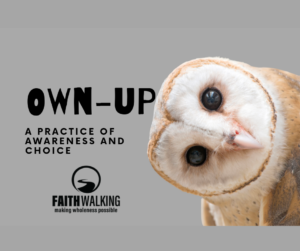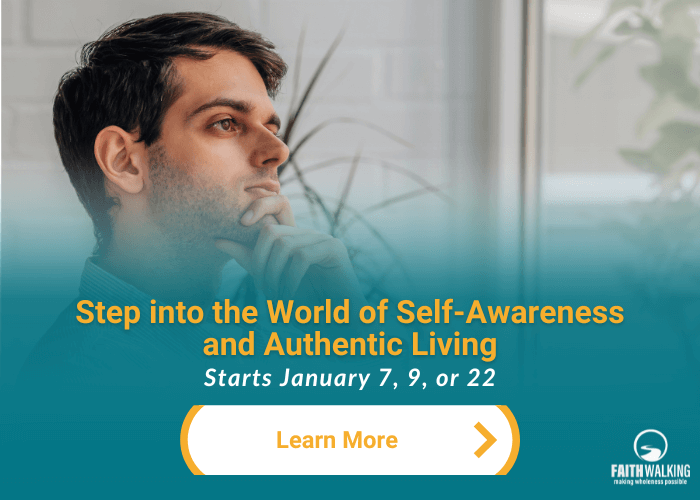Marilyn Vancin, in her book Self to Lose – Self to Find: A Biblical Approach to the 9 Enneagram Types, uses the acronym OWN-UP to provide a helpful practice for those who are actively engaging in the journey of transformation. I believe this exercise is valuable for the following reasons:
- It provides a concrete opportunity to practice awareness. We often say that it is really hard to take off the self we cannot see. We need to train ourselves to increase our capacity to see ourselves, to see the way we are showing up in a given moment. Especially in those moments when it is our false self (“adaptive self” in Vancin’s language) that is driving the bus.
- It provides a concrete opportunity to remember and to practice enacting our guiding principles. We may have done a lot of work identifying and clarifying the principles we want to guide our decisions and our actions. We may have worked in creating a positive declaration that will help us to be our best self, our true self. But if we don’t have the opportunity to incarnate that self in our actual behavior, all that hard work won’t produce the transformation that we are hoping for.
When awareness creates space for freedom, we have the chance to experience real breakthrough in our lives. Experiences of breakthrough become the new evidence we desperately need to empower our transformational learning; if we don’t have them, our learning is merely conceptual.
Below is a simplified explanation of the OWN-UP exercise:
O – Observe
This is the beginning. We are to pay attention and observe what is going on in us with genuine curiosity, in a stance of no judgment and no condemnation. We are to be present to the way we are showing up in a given moment: what we are thinking, what we are feeling, what we are sensing, how we are acting or reacting. We see ourselves – with eyes that actually see with honesty and humility. Are we anxious? Are we defensive? Are we tense? Some helpful ways to observe yourself:
- Be aware of (a) your thoughts, (b) your emotions, (c) any physical sensations, and (d) your behavior. If you have done some work in building your self-awareness, all of these categories will help you consider what is going on inside of you.
- Be aware of (a) subtle patterns you recognize in your behavior: “I notice I am silent and serious in this circumstance, and I know I usually become silent and serious when I am unconsciously distancing from others because I feel threatened or rejected.” And be aware of (b) abrupt reactions or overreactions to given circumstances: “I raised my voice and interrupted him in a way that is not normal for me. I overreacted.” Both of these areas may be unconscious at first. They often provide a window to the ways of our false self.
W – Welcome
Welcoming the awareness of how we are showing up in a given moment does not mean accepting or condoning our unhelpful behavior or our inappropriate thoughts and reactions. It means adopting a humble posture of learning and opening our internal space for revelation and discernment. This is often counterintuitive. Our automatic reaction to unpleasant thoughts and emotions is rejection, not embrace. However, those thoughts and emotions may be the vessels of God’s revelation for us. Only an attitude of openness will help us learn and heal. If we adopt a posture of learning instead of a posture of moral judgment and self-condemnation, we open a window for learning.
- Silence, stillness, and breathing are helpful as you learn to welcome the evidence of your false self. Be reminded of (a) God’s loving grace and capacity to sustain you in the truth of a given moment, and (b) Christ’s presence inside of you as your “hope of glory.”
- An adaptation of the welcoming prayer may be a useful tool to use in this step of the OWN-UP exercise.
N – Name
This is the time to name what is behind your thoughts, emotions, and behaviors. Vancin reminds us that to name is to know. Knowing what is going on inside of us allows us to identify those old patterns of making unconscious meanings and living as if they are the “truth” about ourselves, others, and the world. This awareness allows us to identify our learned behaviors, our autopilot, our defensive routines, our anxiety, etc. Naming them allows us to identify and focus on what we are really dealing with. As Jesus often identifies the demon by asking his name, we are to identify our own internal “demons” by naming them. We are not implying here that we have demons inside of us; we are not posing a theological argument about demons. We are only using a metaphor for the importance of being able to name and expose what is going on inside of us.
- As you name what is going on inside of you, it is useful to remember what you know about yourself – the work you may have done with regard to the experiences of your first formation and identifying your vows, your defensive routines, and the ways your react to shame or anxiety. All of this knowledge about yourself allows you to see and make connections.
- It is important to remember that you are at the same time your true self and your false self; you bear God’s image and gifts to the world, and you also bear your brokenness; you enact inspiring guiding principles to rule your life, and you engage in the broken behaviors of your negative vows. So, learn to name both – the beauty and the ugliness, the longing for God and the resistance to God, and the unhelpful attachments of your broken self.
U – Untangle
Untangling means releasing. After observing, welcoming, and naming what is going on inside of us, we are ready to release, to let go of what we recognize is not coming from our true self. We are now able to see our defensiveness, the meanings and stories we are creating about ourselves, others, and the world. Untangling or releasing requires trust (faith), intentionality, and a great deal of humility. Only when we release our attachment to the crazy cycle of our false self can we be open to receiving the new possibilities of our true self. Remember: we can’t take off the self we cannot see, and we cannot put on the new self if we have not first released the old one.
- A helpful tool: focus on releasing the tension that is present in your body. Close your eyes and be present to the resistance and tension that your body is holding. Breathe slowly and deeply a couple of times, and beginning with your feet, focus on intentionally releasing any tension that your feel. Move to your legs, your belly, your chest, arms, shoulders, neck, and face. You can open the palms of your hands as a physical reminder of your intention to let go.
- Prayer here is important. Be honest in prayer, acknowledge the struggle, and eventually choose to let go. Allow your burden to be taken from you.
P – Possess
Finally, it is time that you become the real you. This is the time to remember who you really are, the time to choose to be who you want to be. You probably have done some good work in learning to define yourself (to be authentically you while remaining open and connected to others). Now you have the opportunity to reap the fruit of that work by applying your learning in this particular circumstance. You have released the deep tension of the struggle, and you are ready to embrace the possibility of your true self. The “possess” stage of this exercise is simply to wonder about and describe what your true self would do in this circumstance and how he or she would do it.
- Remember that your spiritual journey (and your emotional maturity) is about learning. You often learn not by doing something right the first time, but through your mistakes. That is normal! Receive the grace of a second chance to do it better – the grace of being able to be responsible for your own growth, of being able to clean up your messes, and of giving your word to keep learning.
- Helpful tools at this stage are your guiding principles and your positive declarations. They will remind you of the gifts of your true self.
That’s it! The OWN-UP exercise is a useful tool for practicing self-awareness and enabling us to remember who we want to be in a given circumstance. It provides the space to help us remember and integrate the work we have done around guiding principles and positive vows.
For reflection:
- Reflect on this exercise as a tool for your own learning:
- What is most challenging about it for you? Where do you think you may get stuck? Why?
- What about it is life-giving? Why?
- What would be helpful for you to put into practice?
- Reflect on this exercise as a tool for you as a coach:
- How can you coach somebody in the OWN-UP?
- What would be helpful for you in learning to do it?



